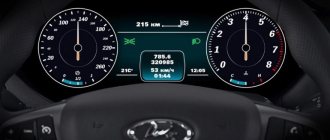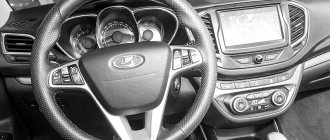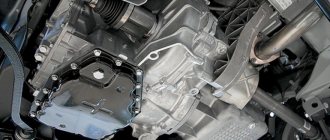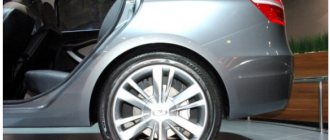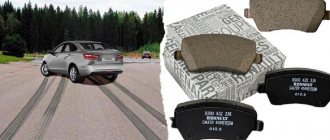Comparison of Lada Vesta with Lada X Ray
Technical features of the machines
Differences between cars in the interior
Many fans of the domestic automobile industry are interested in the question: which is better Lada Vesta or Lada X Ray? Both cars are currently flagships in the AvtoVAZ model range. Appearing on Russian roads in 2015, Lada Vesta and Lada X Ray won recognition and admiring reviews from their newly minted owners. Using technical data and a description of the external features of the cars, including photos, you can compare these two models.
Similar, but not brothers
It is immediately necessary to clarify one point, which for some reason still causes controversy. Vesta is not a variation of Logan. It has nothing to do with the “renowned” B0 platform at all.
Largus has it, Xray has it too, and Vesta is the last one (at the moment
, although everything is going to the point that
in general
) a purely Tolyatti project on native units and a platform of its own design.
Vesta is not B0 and not Logan. “Logan” and other developments of the Romanian Dacia have nothing to do with “Vesta”.
But Xray is a different story. By and large, this is a redesigned Sandero. True, the further, the more Xray moves away from its progenitor. It got to the point that the “Cross” version has its own front suspension, subframe, not to mention the original VAZ engines like the 16-valve 1.6 liter and the Tolyatti 1.8 liter.
Nevertheless, “Sander’s” ears stick out, at least in the cabin, because that’s how it’s built into the B0 platform. This is where we begin with a clash between relatives (but not “brothers”!) butting heads.
Also read: Forward dads: can LADA XRAY be better than Renault Sandero Stepway II
Dimensions and convenience
Formally, both Lada Vesta and X-Ray play in the classic B-class, that is, they are close in weight, size and dynamic characteristics, for example. But Vesta is better in everything.
Hanging over the Xray is the dreaded legacy of the B0 platform in the form of a narrow cabin, so even two broad-shouldered passengers in the back row will inevitably rub against each other. There is no room for legs either, and the trunk of 361 liters is a laughing stock.
Vesta with its 480 liters is also not an example of capacity, but compared to the Xray the difference is significant. By the way, according to the passport, the trunk of the station wagon holds the same 480 liters as the sedan, but there is a slight trick here. Vesta SW and SW Cross can be loaded under the ceiling, while the sedan's capacity is limited by the height of the trunk lid. So, to the 480 passport liters, you can safely add another 150-200 on top, literally.
But not only is the Vesta better than its relative in the trunk - the interior is still closer to class "C" than to "B". It is larger in all dimensions, and it is much more comfortable to sit there even in down jackets and hats on both rows. And overall, she is much better suited for the role:
- family car;
- car for travel.
The LADA Xray can be looked at as an urban version of a single person or a very young family who is just getting ready for strollers in the trunk and mud covers for the seat. And with the birth of your first child, the X-Ray will become crowded, so look at the start what is more important to you: compact dimensions and the form factor of a hatchback, or also compact dimensions, but in the form factors of a sedan or station wagon.
Also read: Exceeded expectations: test drive LADA Vesta
Technical characteristics of Lada Vesta and Lada Xray
Engines Lada Vesta and X-Ray
But here X-Ray outright outplays his opponent. After all, a hatchback can offer 3 engines at once, while the buyer of Vesta will have to be content with only one.
Common to both models is the domestic, 106-horsepower engine of the VAZ-21129 series. This is a time-tested unit with a simple and reliable design - 4 cylinders, 16 valves and a distributed fuel injection complex. Its power is not prohibitive, but for a class B sedan and a compact hatchback it is 106 hp. With. at 5,800 rpm it will be quite enough. Of course, it won’t demonstrate miracles of dynamics, but it will accelerate Vesta to hundreds in 11.2 seconds, and X-Ray in 11.4 seconds. quite capable. This is quite understandable, because the same power and almost identical mass have an effect. But the maximum speed of the hatchback is 1 km/h higher – 176 km/h versus 175 km/h. The appetite of the Lada X-Ray is a little larger - 9.3/7.2/5.9 liters and 9.3/6.9/5.5 liters for Vesta. Consequently, when choosing a car with such an engine, dynamic performance and consumption will not play a role.
A 106-horsepower gasoline engine under the hood of X-Ray.
But if the Lada Vesta exhausts its engine range, then X-Ray can offer a couple more units. There is also a 110-horsepower engine in the stash. This is the same volume 1.6-liter engine of the HR16DE series, but already developed by the Renault-Nissan Alliance. In general, its design replicates that of the 106-horsepower engine. Initially, the power unit was supposed to develop 116 hp. s., however, the power was reduced to adapt it to domestic realities. Be that as it may, this option is preferable - it is a little more dynamic, more economical, and the cutoff is located a little higher. You can accelerate from 0 to 100 km/h in 11.1 seconds, reaching a peak speed of 181 km/h. Consumption is also less - 8.9/6.8/5.6 liters.
A 110-horsepower unit looks preferable for a hatchback.
However, it was not the imported engine that became the top one, but another domestic unit. Lada XRAY was equipped with an innovative 1.8-liter engine of the VAZ-21179 series. The design is no different from the previous ones, but the increase in volume had an effect - 122 liters. With. power at 6,000 rpm, together with 170 Nm of torque at 3,750 rpm, provide acceleration to 100 km/h in 10.9 seconds, and another 186 km/h top speed. The appetite is the same as that of the 110-horsepower engine - 8.6/6.8/5.8 liters. Of course, from a volume of 1.8 liters you expect greater agility and a greater gap in dynamics, but the 5-speed robot that is paired with the engine hides the feeling of acceleration and does not allow the engine to open up to its fullest, but there is no mechanical version for it.
But the best option is still the 1.8-liter Lada X-Ray engine.
Therefore, if dynamics are important to you and the engine is a priority, it is better to pay attention to X-Ray. Soon the situation will partially change, because in the fall of 2016 AvtoVAZ promises to begin equipping the Lada Vesta with a 1.8-liter engine, which will allow it to be in many respects on par with the X-Ray. But the installation of a 110-horsepower engine under the hood of the sedan is being postponed due to the high cost, and the timing is not specified.
Transmissions Lada Vesta and Lada Xray
Regarding gearboxes, the situation is almost identical. Both cars have a pair of manual gearboxes and an AMT robotic gearbox. They are all 5-speed. The only difference is that Vesta has one domestic box (VAZ-2180), and the second French (JH3 510).
Manual transmission in the Lada Vesta interior.
X-Ray is equipped exclusively with foreign transmissions (from the same France) - JR5 512 and JH3 518. But in general, there is no significant difference between them. The components work clearly, the levers are quite short-throw, the gears do not fly out, and there is no unpleasant background noise. In general, everything is done in the best traditions of the modern B-class!
Another French manual transmission, but this time in the Lada X-Ray.
You won’t be able to see a classic “automatic” in any of the models. This was done for reasons of economy, because installing a robotic transmission is cheaper. But riding with it also turns out to be nervous - there are more jerks and jolts, and the reaction to the kick-down command is sometimes delayed. However, all these shortcomings are not critical and only require getting used to - many owners of Vesta and X Ray are more than happy with such a box.
Both Lada XRAY and Lada Vesta have AMT type robots.
Suspension Lada Xray and Lada Vesta
Despite the fact that many are trying to position X Rey as a crossover, such a desire has no basis. AvtoVAZ is not lying when it says that this is just a tall hatchback. And the best confirmation of this is the absence of an all-wheel drive system even in the optional list. Like Vesta, there is only the front one.
At the rear of the Lada X-Ray there is a simple torsion beam.
The chassis design is the same. This is an independent, spring front suspension with MacPherson struts and a stabilizer. At the rear, due to budgetary aspirations, there was no room for a multi-link - only a torsion beam.
The suspension of the Lada Vesta is also extremely simple.
Functionality and equipment
Here, in comparison, “Vesta” and “X-Ray” there is complete parity. Throughout the entire life cycle, AvtoVAZ updates both models, and if one receives something new, it will immediately debut on its brother.
Got Xray 17-inch wheels? Vesta SW Cross will also receive it. Did you get the Xray CVT from Renault? He will also get to Vesta. From the latter, both received a newfangled system with Yandex, so there are equal opportunities here too.
So you can’t say: “We need to buy Vesta, X-Ray is poorer.” No, they are equally not poor. If you choose, it will be based on other parameters. They will be discussed below.
Also read: Russian engineers have finally created a worthy thing: reviews from LADA XRAY owners
Body range of Vesta and X Ray
There is no need to talk about prestige in this case, since both models came off the assembly line of the same plant. And the buyers themselves still haven’t decided which one has more status. But the differences in terms of the body are much more significant.
Future station wagon from Lada Vesta.
So far, the Lada Vesta is sold as a sedan, but its significant expansion is being prepared - this will include a hatchback, a station wagon, a long-wheelbase version of the Lada Vesta Signature, and a pseudo-off-road Lada Vesta Cross. Therefore, soon new products from the Togliatti plant will fall like ripe apples!
Lada Vesta Cross car!
The Lada Xray acts exclusively as a hatchback (although many are persistently trying to present it as a crossover), and there can be no other option, excluding only the Lada XRAY Cross modification, which will soon appear on the market. However, apart from the plastic body kit, possible all-wheel drive and some other aspects, it will not differ in anything from the standard one.
Hatchback Lada X Ray Cross.
Ultimately, the choice of body depends on personal preference. If you need a sedan, then there is no other option other than Vesta. But when choosing a hatchback, you can either take the X-Ray, or wait for the production of its counterpart in the same body. There are no alternatives with a station wagon - just hope for the speedy release of the Vesta car.
Long-wheelbase modification of Lada Vesta Signature.
Ride and Handling
Let's go back to the beginning and say once again that Vesta is a purely Togliatti product with Togliatti engineering and settings. Yes, the fine tuning of the chassis was carried out at a training ground in Spain, but it was done by our specialists. That is, there is no Romanian or French trace, and this greatly benefited Vesta.
In terms of handling in general and some minor nuances - taxiing, in particular - it is much better not just than the X-Ray, but also almost all competitors in this size. Neither Solaris nor Rio, even with the entire rear suspension redesigned a hundred times, will give you such emotions. You can probably get it from Polo and Rapid, but they are much more expensive.
And Vesta fits into the budget and drives in a way that an inexpensive car should not drive. She is precise, sharp and obedient. As for Xray...
On the one hand, the car inherited Logan’s elasticity of ride and the ability to hover over pits (but not on “seventeenth” wheels). On the other hand, the rolliness, inertia and disobedience inherent in the B0 platform also transferred to it like a trailer.
Therefore, the LADA Xray is most likely suitable for those who do not bother at all with the sensations on the road. Do you need to drive and have fun? Then it’s worth buying Vesta - “X Ray” for those times when you just need to be lucky and not infuriate. Emotions are on the side.
Also read: The best of Ladas: LADA Vesta review
Main overall dimensions and appearance
Both models are made in the same stylish design with a pronounced letter X on many parts of the cars. The head optics and the front part of the body with the radiator grille are practically the same. Identical X-shaped stampings on the fenders and doors of cars attract the attention of others. The interior and ergonomics of the cabin have minor differences.
Comparison of Lada Vesta with Lada X Ray It is impossible to compare both of these models on the same scale. First of all, they are made in different body types, which means that a comparative analysis must be carried out taking into account this important design difference.
| Options | Lada X-Ray | Lada Vesta |
| Length/width/height (mm) | 4165/ 1764/ 1570 | 4410/ 1764/ 1497 |
| Wheelbase (mm) | 2592 | 2635 |
| Body/number of doors | Crossover/5 | Sedan/4 |
| Ground clearance (clearance) (mm) | 195 | 178 |
| Luggage compartment volume (l) | 361 | 480 |
| Curb/maximum weight (kg) | 1190/1650 | 1230/1670 |
| Fuel tank volume (l) | 50 | 55 |
The X Ray crossover, thanks to its significant ground clearance and short wheelbase, has advantages on roads with worse surfaces and on poor off-road conditions. In terms of dynamic characteristics, it loses to the more stocky and streamlined Lada Vesta sedan, whose center of gravity is lower and stability on the highway is much better than its competitor. If you compare the Lada Vesta in city traffic on the asphalt, in terms of maneuverability it is not much different from the X Ray.
Maintenance and pain
It’s worth mentioning separately about the service. Overall, they are both strong and have no bottlenecks. In the first years of production, the Lada Vesta had plenty of them in comparison with the Lada X-Ray. But AvtoVAZ responded quite quickly to the feedback and by the end of 2016 had rolled out several update packages to Vesta. They concerned, in particular, small parts of the front suspension (the links began to rattle very early), and the plant even had to change suppliers to new ones for this.
At first, Xray also suffered from childhood problems such as defective coolant expansion tanks, but even there the plant quickly took action - and not only on the tank. Already at the end of 2016, the Xray had a button to disable the anti-skid, which was not provided for in the original design. The box there was also promptly changed to a French one so that it would not make noise. And what are we all talking about? For once, AvtoVAZ began to listen very sensitively to what they were saying about it, and promptly corrected itself.
Therefore, on relatively fresh (and old too) Lada Vesta / X-Ray, they cured what they could, and new sores, if they appear, are then as a projection of the owner’s character, and not as a design / assembly feature.
Also read: LADA Xray: the whole truth from the owner’s lips
Differences between Lada Vesta and Lada X-Ray
They consist in the fact that the Lada Vesta is a fundamentally new development of AvtoVAZ, and many are even tired of waiting for its appearance, because there have been conversations about it for at least several years, if not a whole decade. X Ray, what to hide, is just a deeply redesigned Renault Sandero Stepway, which itself is based on the familiar, indestructible Logan.
The development of the Lada Vesta sedan went long and hard.
What to choose - proven reliability over the years, albeit in a new shell, or innovation, so advertised by AvtoVAZ? Experience suggests that Russians are more inclined to trust proven solutions.
It was on the basis of the Renault Sandero Stepway that the Lada X-Ray was created.
Typical problems on the secondary market
The relatively smooth reputation of cars should not be misleading. In the secondary market, you can’t trust anyone, everything needs to be double-checked, so at the very least you should show the car to a diagnostic specialist before purchasing. In general, it’s never superfluous to put it on a lift.
In order not to waste a diagnostician and waste extra time on service visits, it is worth studying the report on the specimen of interest. There, perhaps, it will immediately become clear whether to get up from the sofa for inspection.
The real scourge of used West cars is their use in taxis. It’s good if the seller does not hide this and posts photos with identifying marks.
But if the seller was not a cat and hid information about working in a taxi, a history check would come to the rescue. We try Vesta through the avtocod.ru service and see a lot of problems.
The car was hit from the front.
You can’t register it anyway, because there are restrictions.
There are 61 fines totaling almost 55 thousand rubles.
Due to debts, enforcement proceedings were brought against the seller. It's better to close the ad. Taking taxi driver's cast-offs with legal problems for personal use is more expensive for yourself.
It’s a little easier with X-rays: they are less often used in taxis. But there is another scourge - loans. It is very difficult to find a car that is not mortgaged; every time you come across some kind of encumbrance. Like here, for example.
Avtocod.ru showed the deposit.
A twist in mileage was also discovered.
Of course, you can sort all this out, but it will take a long time: negotiate with the owner, go to the bank with him, make sure he doesn’t deceive you, pay off the debts, and remove the deposit from the car. For what? After all, you can look for more Xray.
Also read: Who is sportier: LADA Vesta Sport I or Skoda Rapid I turbo
Inexpensive roomy sedans (price up to 800 thousand rubles)
| № | Car model | L1, mm | H1, mm | B1 / B2, mm | H, mm | L2, mm | H2, mm | Avg. meaning |
| 1 | Kia Cerato | 980–1210 | 1010 | 1430 / 1360 | 1185 | 655–905 | 940 | 1148,571 |
| 2 | Hyundai Elantra | 990–1220 | 1010 | 1435 / 1380 | 1185 | 640–875 | 930 | 1147,857 |
| 3 | Nissan Sentra | 970–1170 | 1025 | 1395 / 1365 | 1195 | 710–945 | 930 | 1146,429 |
| 4 | Skoda Rapid | 955–1170 | 1020 | 1390 / 1355 | 1180 | 680–925 | 945 | 1140,714 |
| 5 | Ford Focus | 985–1185 | 1030 | 1415 / 1305 | 1190 | 605–860 | 950 | 1133,571 |
| 6 | Ravon Gentra | 965–1145 | 1015 | 1395 / 1350 | 1170 | 660–890 | 960 | 1132,143 |
| 7 | Renault Logan | 960–1190 | 1030 | 1375 / 1375 | 1210 | 645–865 | 960 | 1132,143 |
| 8 | Lada Vesta | 975–1175 | 1020 | 1385 / 1370 | 1190 | 610–850 | 925 | 1130,714 |
| 9 | VW Polo GT | 955–1150 | 1010 | 1380 / 1370 | 1180 | 635–880 | 935 | 1129,286 |
| 10 | Kia Rio | 990–1180 | 1030 | 1360 / 1325 | 1195 | 575–820 | 930 | 1120 |
| 11 | Hyundai Solaris | 970–1190 | 1015 | 1365 / 1325 | 1200 | 565–810 | 925 | 1117,857 |
| 12 | Ford Fiesta | 980–1165 | 1005 | 1360 / 1265 | 1190 | 575–790 | 925 | 1100 |
The budget sedan with the most spacious interior turned out to be the Kia Cerato. Vesta's interior dimensions are approximately the same as those of the Ford Focus, Ravon Gentra, Renault Logan and VW Polo GT. The main competitors of the domestic car (Kia Rio and Hyundai Solaris) cannot boast of interior dimensions; they are located at the end of the list.
By the way, AVTOVAZ previously showed the Lada Vesta Signature, the body of this modification was lengthened by 25 cm.
Let us remind you that earlier we looked in more detail at the dimensions of the interior, body and trunk of Lada Vesta and XRAY cars.
0 0 0 0 0 0
Share on social networks:



